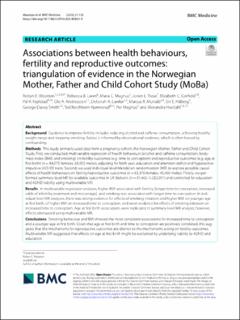| dc.contributor.author | Wootton, Robyn E. | |
| dc.contributor.author | Lawn, Rebecca B. | |
| dc.contributor.author | Magnus, Maria C. | |
| dc.contributor.author | Treur, Jorien L. | |
| dc.contributor.author | Corfield, Elizabeth C. | |
| dc.contributor.author | Njølstad, Pål Rasmus | |
| dc.contributor.author | Andreassen, Ole A. | |
| dc.contributor.author | Lawlor, Deborah A. | |
| dc.contributor.author | Munafò, Marcus R. | |
| dc.contributor.author | Håberg, Siri E. | |
| dc.contributor.author | Smith, George Davey | |
| dc.contributor.author | Reichborn-Kjennerud, Ted | |
| dc.contributor.author | Magnus, Per | |
| dc.contributor.author | Havdahl, Alexandra | |
| dc.date.accessioned | 2023-04-25T11:28:07Z | |
| dc.date.available | 2023-04-25T11:28:07Z | |
| dc.date.created | 2023-04-24T09:39:42Z | |
| dc.date.issued | 2023 | |
| dc.identifier.issn | 1741-7015 | |
| dc.identifier.uri | https://hdl.handle.net/11250/3064923 | |
| dc.description.abstract | Background
Guidance to improve fertility includes reducing alcohol and caffeine consumption, achieving healthy weight-range and stopping smoking. Advice is informed by observational evidence, which is often biased by confounding.
Methods
This study primarily used data from a pregnancy cohort, the Norwegian Mother, Father and Child Cohort Study. First, we conducted multivariable regression of health behaviours (alcohol and caffeine consumption, body-mass index (BMI), and smoking) on fertility outcomes (e.g. time to conception) and reproductive outcomes (e.g. age at first birth) (n = 84,075 females, 68,002 males), adjusting for birth year, education and attention-deficit and hyperactive-impulsive (ADHD) traits. Second, we used individual-level Mendelian randomisation (MR) to explore possible causal effects of health behaviours on fertility/reproductive outcomes (n = 63,376 females, 45,460 males). Finally, we performed summary-level MR for available outcomes in UK Biobank (n = 91,462–1,232,091) and controlled for education and ADHD liability using multivariable MR.
Results
In multivariable regression analyses, higher BMI associated with fertility (longer time to conception, increased odds of infertility treatment and miscarriage), and smoking was associated with longer time to conception. In individual-level MR analyses, there was strong evidence for effects of smoking initiation and higher BMI on younger age at first birth, of higher BMI on increased time to conception, and weak evidence for effects of smoking initiation on increased time to conception. Age at first birth associations were replicated in summary-level MR analysis; however, effects attenuated using multivariable MR.
Conclusions
Smoking behaviour and BMI showed the most consistent associations for increased time to conception and a younger age at first birth. Given that age at first birth and time to conception are positively correlated, this suggests that the mechanisms for reproductive outcomes are distinct to the mechanisms acting on fertility outcomes. Multivariable MR suggested that effects on age at first birth might be explained by underlying liability to ADHD and education. | en_US |
| dc.language.iso | eng | en_US |
| dc.publisher | BMC | en_US |
| dc.rights | Navngivelse 4.0 Internasjonal | * |
| dc.rights.uri | http://creativecommons.org/licenses/by/4.0/deed.no | * |
| dc.title | Associations between health behaviours, fertility and reproductive outcomes: triangulation of evidence in the Norwegian Mother, Father and Child Cohort Study (MoBa) | en_US |
| dc.type | Journal article | en_US |
| dc.type | Peer reviewed | en_US |
| dc.description.version | publishedVersion | en_US |
| dc.rights.holder | Copyright The Author(s) 2023 | en_US |
| dc.source.articlenumber | 125 | en_US |
| cristin.ispublished | true | |
| cristin.fulltext | original | |
| cristin.qualitycode | 2 | |
| dc.identifier.doi | 10.1186/s12916-023-02831-9 | |
| dc.identifier.cristin | 2142729 | |
| dc.source.journal | BMC Medicine | en_US |
| dc.relation.project | Norges forskningsråd: 262700 | en_US |
| dc.relation.project | Helse Sør-Øst RHF: 2020024 | en_US |
| dc.relation.project | Norges forskningsråd: 288083 | en_US |
| dc.relation.project | Norges forskningsråd: 274611 | en_US |
| dc.relation.project | Norges forskningsråd: 300668 | en_US |
| dc.relation.project | Norges forskningsråd: 320656 | en_US |
| dc.relation.project | ERC-European Research Council: 947684 | en_US |
| dc.relation.project | ERC-European Research Council: 101021566 | en_US |
| dc.relation.project | Norges forskningsråd: 229624 | en_US |
| dc.relation.project | Norges forskningsråd: 223273 | en_US |
| dc.identifier.citation | BMC Medicine. 2023, 21, 125. | en_US |
| dc.source.volume | 21 | en_US |

